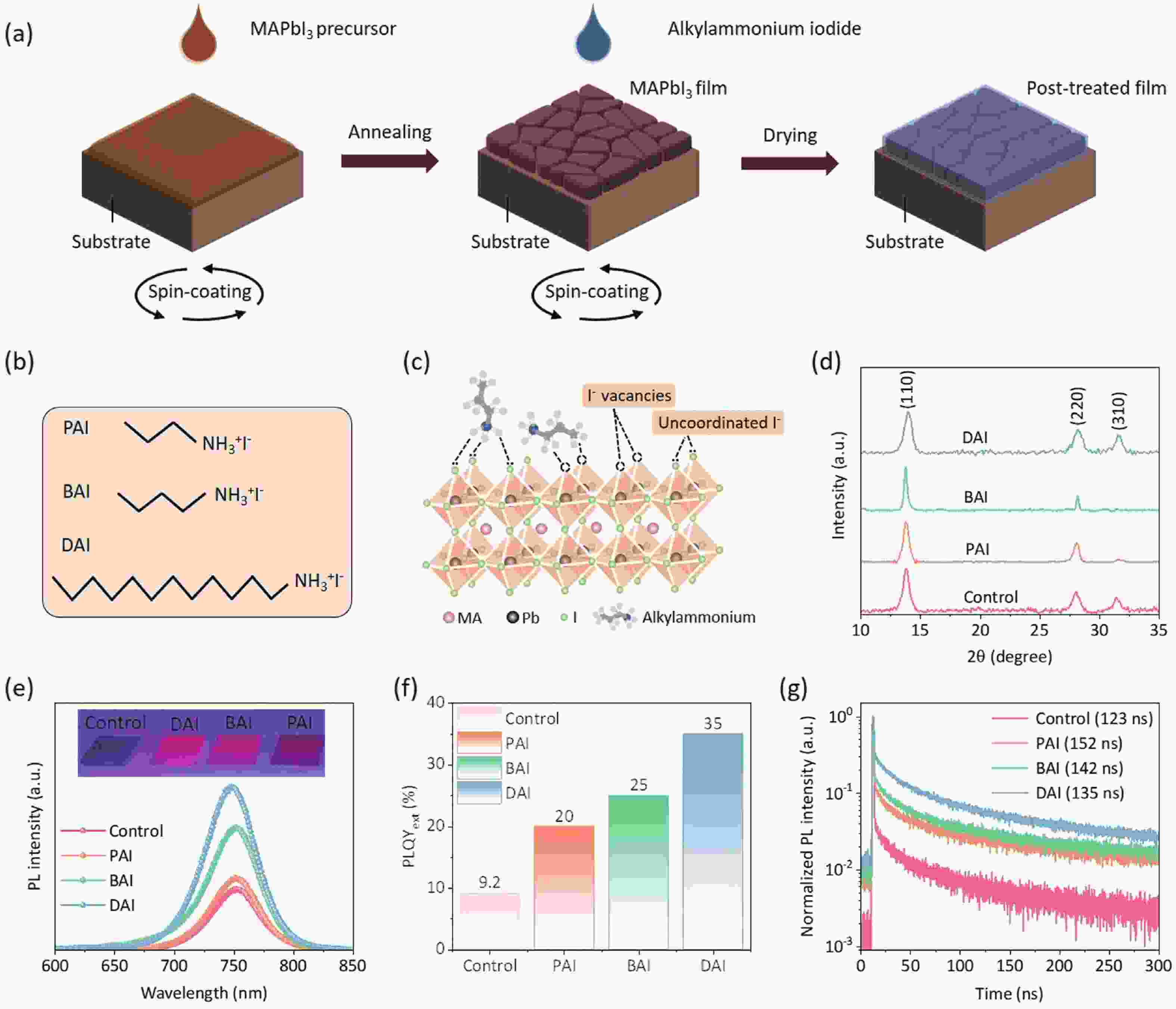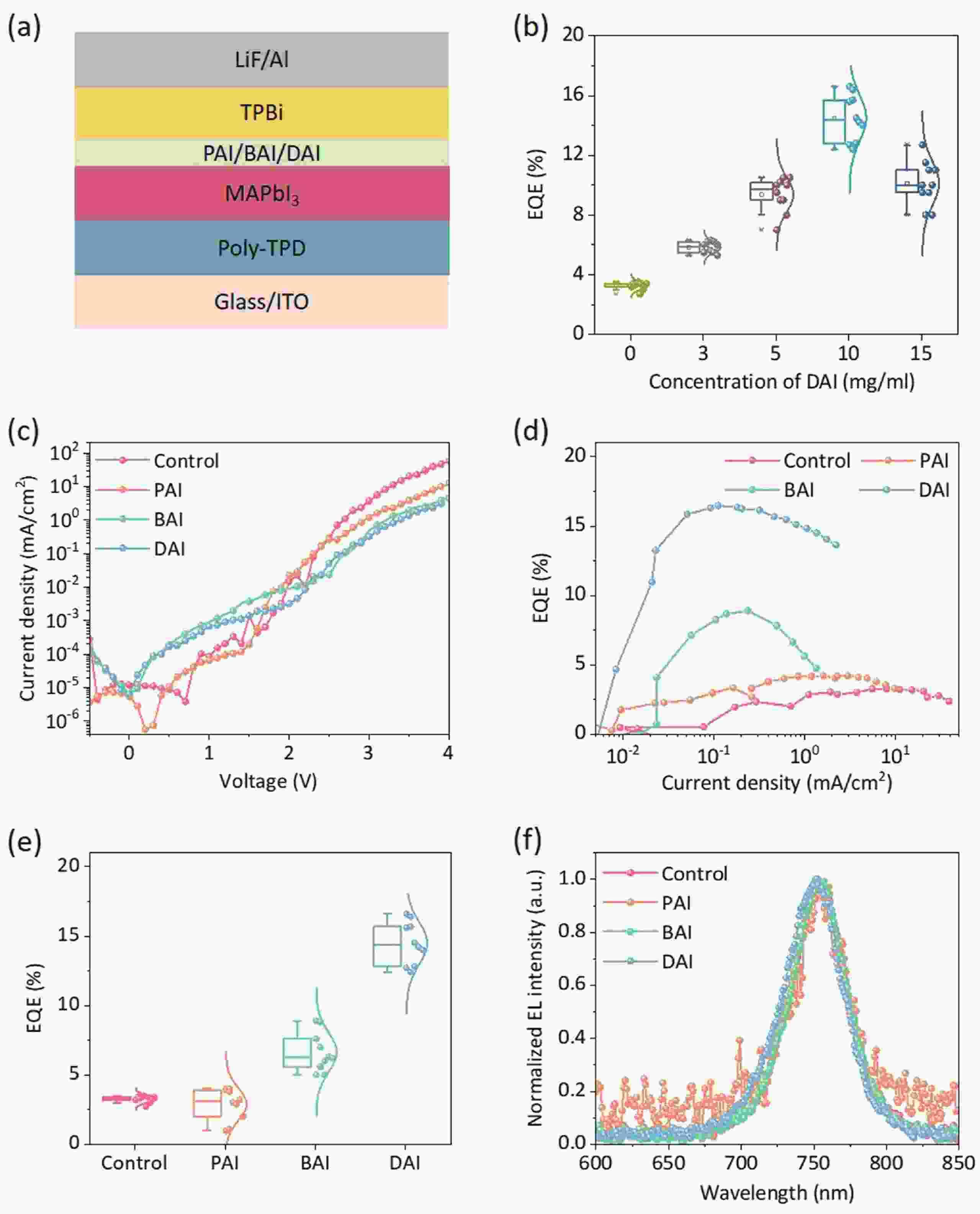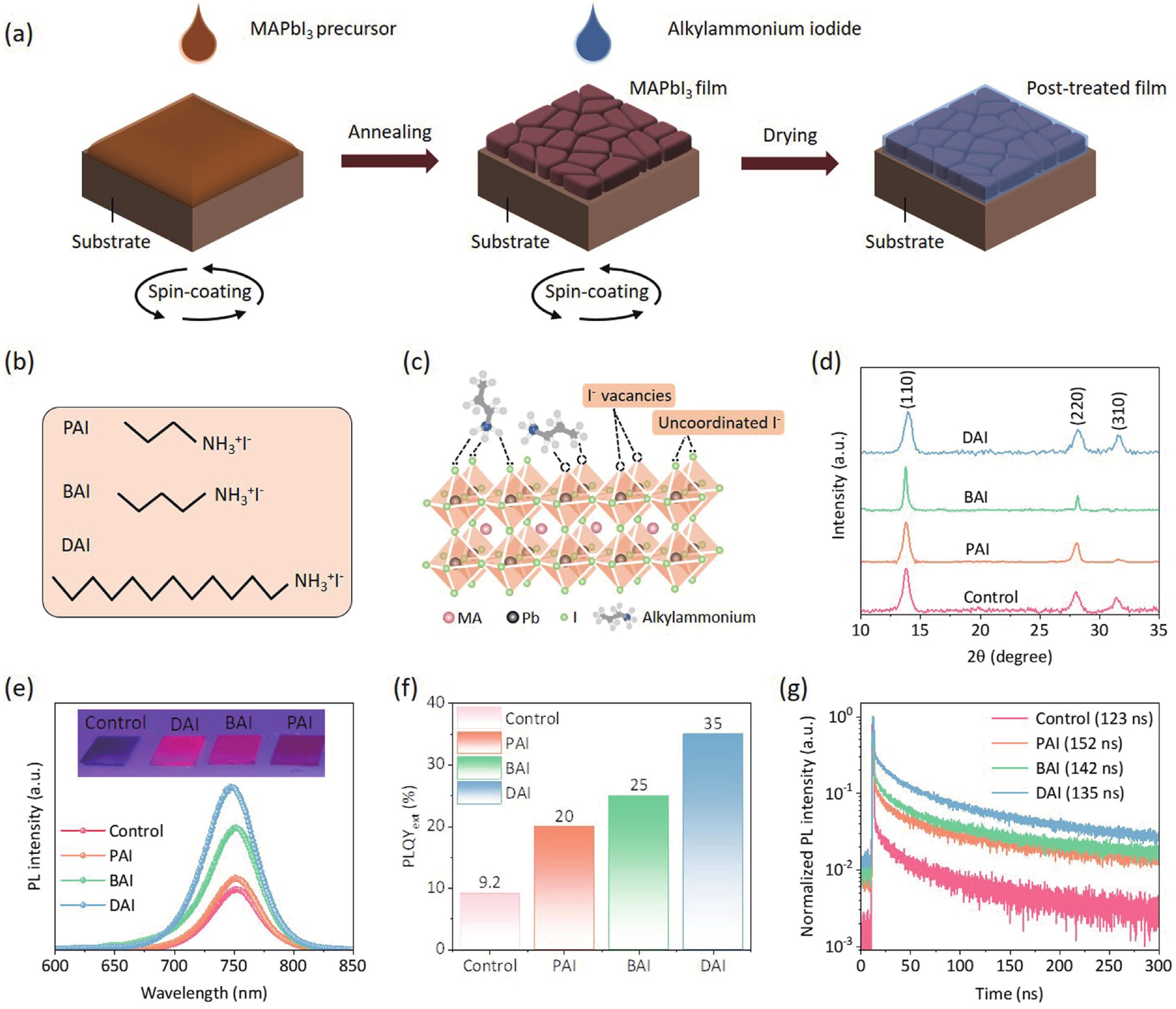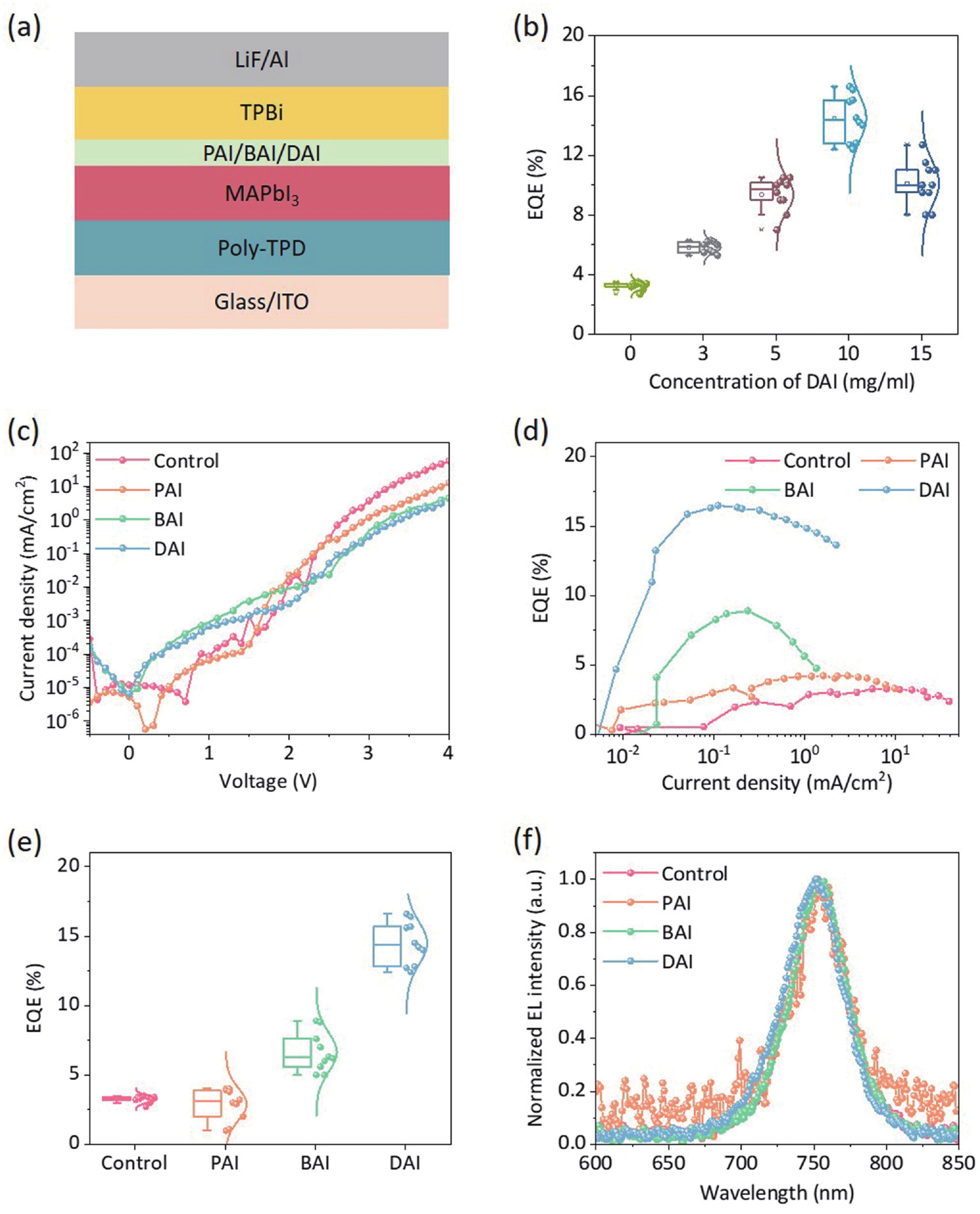| Citation: |
Rashid Khan, Guangyi Shi, Wenjing Chen, Zhengguo Xiao, Liming Ding. Interface engineering yields efficient perovskite light-emitting diodes[J]. Journal of Semiconductors, 2023, 44(12): 120501. doi: 10.1088/1674-4926/44/12/120501
R Khan, G Y Shi, W J Chen, Z G Xiao, L M Ding. Interface engineering yields efficient perovskite light-emitting diodes[J]. J. Semicond, 2023, 44(12): 120501. doi: 10.1088/1674-4926/44/12/120501
Export: BibTex EndNote
|
Interface engineering yields efficient perovskite light-emitting diodes
doi: 10.1088/1674-4926/44/12/120501
More Information-
References
[1] Kojima A, Teshima K, Shirai Y, et al. Organometal halide perovskites as visible-light sensitizers for photovoltaic cells. J Am Chem Soc, 2009, 131, 6050 doi: 10.1021/ja809598r[2] Green M A, Ho-Baillie A, Snaith H J. The emergence of perovskite solar cells. Nat Photonics, 2014, 8, 506 doi: 10.1038/nphoton.2014.134[3] Xiao Z G, Yuan Y B, Wang Q, et al. Thin-film semiconductor perspective of organometal trihalide perovskite materials for high-efficiency solar cells. Mater Sci Eng R Rep, 2016, 101, 1 doi: 10.1016/j.mser.2015.12.002[4] Min H, Lee D Y, Kim J, et al. Perovskite solar cells with atomically coherent interlayers on SnO2 electrodes. Nature, 2021, 598, 444 doi: 10.1038/s41586-021-03964-8[5] Zhang S, Ye F Y, Wang X Y, et al. Minimizing buried interfacial defects for efficient inverted perovskite solar cells. Science, 2023, 380, 404 doi: 10.1126/science.adg3755[6] Tan Z K, Moghaddam R S, Lai M L, et al. Bright light-emitting diodes based on organometal halide perovskite. Nat Nanotechnol, 2014, 9, 687 doi: 10.1038/nnano.2014.149[7] Xiao Z G, Kerner R A, Zhao L F, et al. Efficient perovskite light-emitting diodes featuring nanometre-sized crystallites. Nat Photonics, 2017, 11, 108 doi: 10.1038/nphoton.2016.269[8] Chen J, Ma P C, Chen W J, et al. Overcoming outcoupling limit in perovskite light-emitting diodes with enhanced photon recycling. Nano Lett, 2021, 21, 8426 doi: 10.1021/acs.nanolett.1c03035[9] Cheng G Q, Liu Y, Chen T, et al. Efficient all-inorganic perovskite light-emitting diodes with improved operation stability. ACS Appl Mater Interfaces, 2020, 12, 18084 doi: 10.1021/acsami.9b23170[10] Ye D, Li Z J, Chen W J, et al. Stable yellow light-emitting diodes based on quasi-two-dimensional perovskites. ACS Appl Mater Interfaces, 2022, 14, 34918 doi: 10.1021/acsami.2c07314[11] Liu X K, Xu W D, Bai S, et al. Metal halide perovskites for light-emitting diodes. Nat Mater, 2021, 20, 10 doi: 10.1038/s41563-020-0784-7[12] Khan R, Chu S L, Li Z J, et al. High radiance of perovskite light-emitting diodes enabled by perovskite heterojunctions. Adv Funct Mater, 2022, 32, 2203650 doi: 10.1002/adfm.202203650[13] Dou L T, Yang Y, You J B, et al. Solution-processed hybrid perovskite photodetectors with high detectivity. Nat Commun, 2014, 5, 5404 doi: 10.1038/ncomms6404[14] Yakunin S, Sytnyk M, Kriegner D, et al. Detection of X-ray photons by solution-processed lead halide perovskites. Nat Photonics, 2015, 9, 444 doi: 10.1038/nphoton.2015.82[15] Wei H T, Fang Y J, Mulligan P, et al. Sensitive X-ray detectors made of methylammonium lead tribromide perovskite single crystals. Nat Photonics, 2016, 10, 333 doi: 10.1038/nphoton.2016.41[16] Chen Q S, Wu J, Ou X Y, et al. All-inorganic perovskite nanocrystal scintillators. Nature, 2018, 561, 88 doi: 10.1038/s41586-018-0451-1[17] Xiao Z G, Yuan Y B, Shao Y C, et al. Giant switchable photovoltaic effect in organometal trihalide perovskite devices. Nat Mater, 2015, 14, 193 doi: 10.1038/nmat4150[18] Xiao Z G, Huang J S. J Energy-efficient hybrid perovskite memristors and synaptic devices. Adv Electron Mater, 2016, 2, 1600100 doi: 10.1002/aelm.201600100[19] Fang Z, Chen W, Shi Y, et al. Dual passivation of perovskite defects for light-emitting diodes with external quantum efficiency exceeding 20%. Adv Funct Mater, 2020, 30, 1909754 doi: 10.1002/adfm.201909754[20] D’Innocenzo V, Srimath Kandada A R, De Bastiani M, et al. Tuning the light emission properties by band gap engineering in hybrid lead halide perovskite. J Am Chem Soc, 2014, 136, 17730 doi: 10.1021/ja511198f[21] Liu Z, Qiu W D, Peng X M, et al. Perovskite light-emitting diodes with EQE exceeding 28% through a synergetic dual-additive strategy for defect passivation and nanostructure regulation. Adv Mater, 2021, 33, 2103268 doi: 10.1002/adma.202103268[22] Kim J S, Heo J M, Park G S, et al. Ultra-bright, efficient and stable perovskite light-emitting diodes. Nature, 2022, 611, 688 doi: 10.1038/s41586-022-05304-w[23] Bai W H, Xuan T T, Zhao H Y, et al. Perovskite light-emitting diodes with an external quantum efficiency exceeding 30%. Adv Mater, 2023, 35, 2302283 doi: 10.1002/adma.202302283[24] Guo Y W, Apergi S, Li N, et al. Phenylalkylammonium passivation enables perovskite light emitting diodes with record high-radiance operational lifetime: The chain length matters. Nat Commun, 2021, 12, 644 doi: 10.1038/s41467-021-20970-6[25] Kim H, Lee S U, Lee D Y, et al. Optimal interfacial engineering with different length of alkylammonium halide for efficient and stable perovskite solar cells. Adv Energy Mater, 2019, 9, 1902740 doi: 10.1002/aenm.201902740[26] Ye X F, Cai H K, Sun Q H, et al. Alkyl ammonium salt with different chain length for high-efficiency and good-stability 2D/3D hybrid perovskite solar cells. Org Electron, 2022, 106, 106542 doi: 10.1016/j.orgel.2022.106542[27] Feng W H, Zhang C X, Zhong J X, et al. Correlating alkyl chain length with defect passivation efficacy in perovskite solar cells. Chem Comm, 2020, 56, 5006 doi: 10.1039/D0CC01197E[28] Zhao P J, Subbiah J, Zhang B L, et al. Alkyl chain length-dependent amine-induced crystallization for efficient interface passivation of perovskite solar cells. Adv Mater Interfaces, 2023, 10, 2202313 doi: 10.1002/admi.202202313[29] Na H, Meng Q L, Cha J, et al. Passivating detrimental grain boundaries in perovskite films with strongly interacting polymer for achieving high-efficiency and stable perovskite solar cells. Appl Surf Sci, 2023, 626, 157209 doi: 10.1016/j.apsusc.2023.157209[30] Wang F, Bai S, Tress W, et al. Defects engineering for high-performance perovskite solar cells. NPJ Flex Electron, 2018, 2, 22 doi: 10.1038/s41528-018-0035-z[31] Sherkar T S, Momblona C, Gil-Escrig L, et al. Recombination in perovskite solar cells: Significance of grain boundaries, interface traps, and defect ions. ACS Energy Lett, 2017, 2, 1214 doi: 10.1021/acsenergylett.7b00236[32] Shen X Y, Kang K, Yu Z K, et al. Passivation strategies for mitigating defect challenges in halide perovskite light-emitting diodes. Joule, 2023, 7, 272 doi: 10.1016/j.joule.2023.01.008[33] Liu Z, Meng K, Wang X, et al. In situ observation of vapor-assisted 2D-3D heterostructure formation for stable and efficient perovskite solar cells. Nano Lett, 2020, 20, 1296 doi: 10.1021/acs.nanolett.9b04759[34] Shao Y C, Xiao Z G, Bi C, et al. Origin and elimination of photocurrent hysteresis by fullerene passivation in CH3NH3PbI3 planar heterojunction solar cells. Nat Commun, 2014, 5, 5784 doi: 10.1038/ncomms6784[35] Kore B P, Zhang W, Hoogendoorn B W, et al. Moisture tolerant solar cells by encapsulating 3D perovskite with long-chain alkylammonium cation-based 2D perovskite. Commun Mater, 2021, 2, 100 doi: 10.1038/s43246-021-00200-8 -
Supplements
 23100019.docx
23100019.docx

-
Proportional views






 DownLoad:
DownLoad:
















